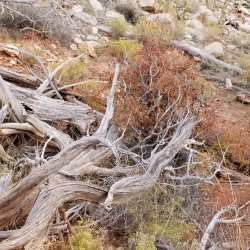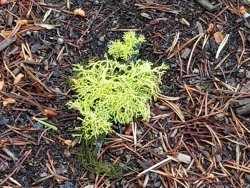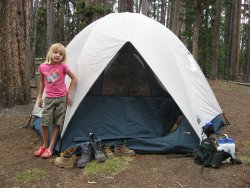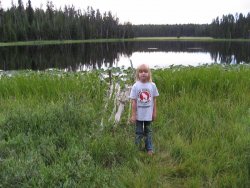A friend from Indiana had come out. We had reservations to hike in the Bechler, in the Meadows area, but she was going to be here for two weeks, so along with some day trips to different places, we opted to do an overnight backpacking trip to someplace that would be different from what we’d see in the Bechler. So with a few options in mind, we hoped to get a nice walk in permit. We got a site at Ribbon Lake. We started at the parking lot at Artist Point. The Lower Falls of the Yellowstone River is THE thing I remember about Yellowstone when we came when I was a kid. It still strikes me as the single most beautiful place in Yellowstone (YMMV). We put on our packs and ambled to the first viewing opportunity and took some pictures. I could stare at that all day, but then I wouldn’t get to our campsite, so we headed to the trailhead. It’s just at the edge of the trail that bazillions of tourists take to get to the Artist Point view point. Most tourists look at the sign and walk away. Some look at the sign and look curious, even longingly at the trail, but they don’t step foot on it. We headed down the path.
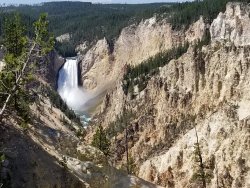
The first mile, or so, is along the edge of the Grand Canyon of the Yellowstone River. I’m not usually too intimidated by heights, but the path here consists of loose gravel-stuff, and I don’t trust it—or me. So, I walk on the side away from the edge. The scenery, both up and downstream, is unlike any scenery I’ve seen anywhere else. We stopped often, to look, and I don’t know about Chris, but I stopped often to catch my breath.
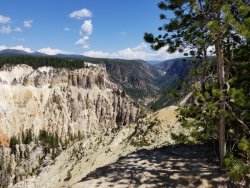
There were lots of well worn viewpoints.
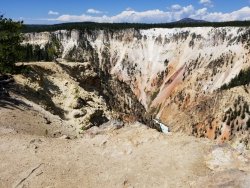
For anyone who wonders why a person might backpack, this picture explains a lot.
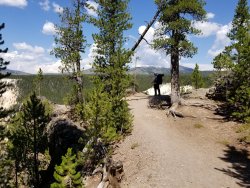
It’s a two and a half mile walk from the trailhead to the campsite. You wander along the edge of the canyon, then down past a lily pond, up a hill and then down a hill, past another campsite, cross a stream, past another magnificent viewpoint, and finally drop down to the campsite. It’s large, in open woods. We hung our food on the food pole, and then went up the hill to set up tents. This site has lots of visitors—people who decided to actually go down the trail, when they saw the trail at Artist Point. This is the second time I’ve been at this campsite, and it’s a little weird having a family clomp through your campsite to go have a picnic at the lake, or sit on the logs at your kitchen to eat sandwiches they brought from—hmm, I wonder where they did get them. They looked really good, and were in styrofoam clamshells. I worried that they might not take all the food and packing with them, and we’d have to worry about bears, but when I looked later, absolutely everything was gone. Yay.
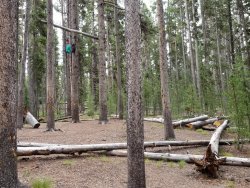
This is Ribbon Lake. The biggest “problem” with this site is that to get water you either have to scramble out on those logs, wade through weeds, or go back up the hill and then down the hill to the stream you crossed earlier. I opted to do the latter.
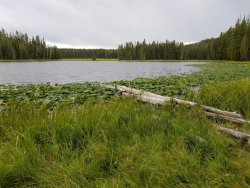
This is a resident of the campsite. He probably dislikes tourists AND people with a backcountry permit for the night.
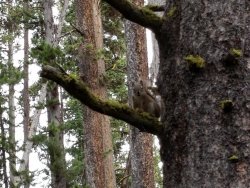
Again, I used my new-to-me Altaplex. It rained this night, and I stayed dry.
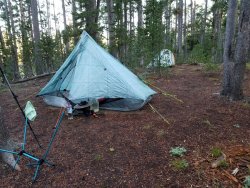
This was Ribbon Lake the next morning, with a light fog rising. It was cool and crisp.
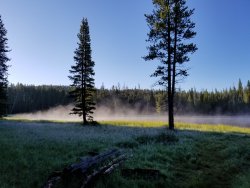
Ribbon Lake looking toward the meadow and other campsite. Someday I’m going to get that other campsite, I hope.
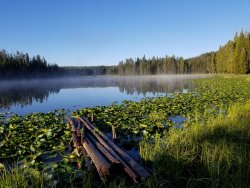
I believe this is a Sora. (The bird.)
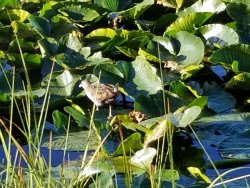
This is the spacious camp kitchen. Up the hill, directly above the blue backpack, is where we had set up our tents. Even though we were a good ways from the lake, this can be a very Mosquito-y campsite.
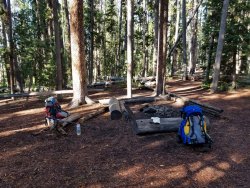
Leaving camp, we went up this trail to the viewpoint.
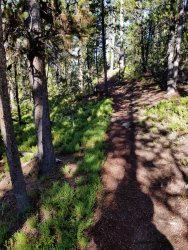
This is the view from the viewpoint. Lots of people day hike to this point. Just beyond the dirt area, in the vegetation, is the outflow creek from the lake. When it tumbles over the side of the canyon wall, it becomes Silver Cord Falls/Cascade. I finally saw it from the other side a few weeks ago. If you don’t know what to look for (high, thin waterfall), you miss it. There is a book that indicates you can see Silver Cord Falls from this side, and it’s incorrect, though people come wandering along, looking for it. I think you could put yourself into a perilous position if you actually got to where you could see it.
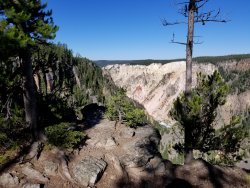
Chris led going up the hill.
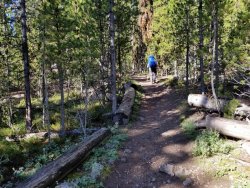
At Lily Pond (Lake?), instead of turning toward the canyon, we headed away from the canyon. Within a hundred yards or so, we came to a thermal area. It has fumaroles, mudpots and a lake that is a hot spring. The trail goes through this area for about half a mile. Unlike the typical Yellowstone thermal feature,
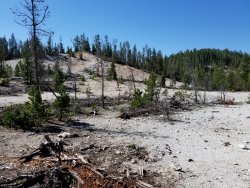
A mudpot.
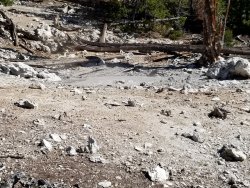
Typical thermal feature area with chalky “soil.”
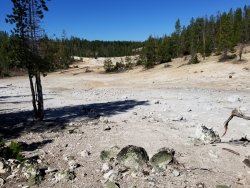
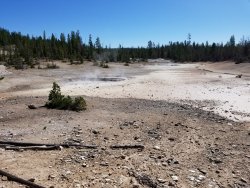
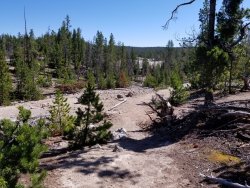
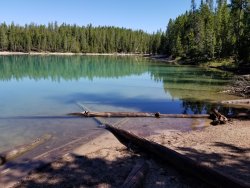
This is Clear Lake. I think it’s a thermal spring, but maybe not. It’s pond size, and has color that sure looks thermal, as well as a few bubbles coming up, that also look thermal in nature.
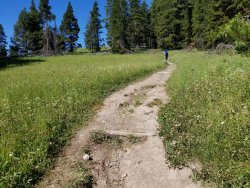
To get back to the car, we headed up the hill toward the parking lot at Uncle Tom’s.
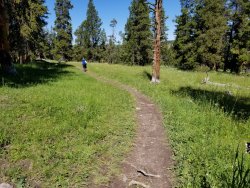
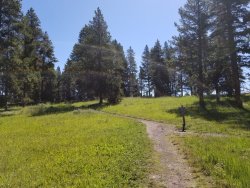
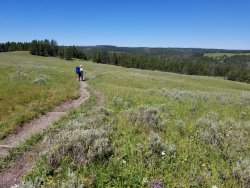
There are a couple of places with very nice viewsheds.
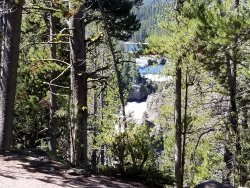
We worked our way down the hill, and to this viewpoint. Our final segment was to hike to the Artist Point parking lot, and head home. This is a nice introductory hike to Yellowstone. You get great vantage points of the Lower Falls of the Yellowstone, and the Grand Canyon of the Yellowstone, as well as a little lake, and a backcountry thermal area. And when you get out, it’s not a far drive to get ice cream at Canyon Village!

The first mile, or so, is along the edge of the Grand Canyon of the Yellowstone River. I’m not usually too intimidated by heights, but the path here consists of loose gravel-stuff, and I don’t trust it—or me. So, I walk on the side away from the edge. The scenery, both up and downstream, is unlike any scenery I’ve seen anywhere else. We stopped often, to look, and I don’t know about Chris, but I stopped often to catch my breath.

There were lots of well worn viewpoints.

For anyone who wonders why a person might backpack, this picture explains a lot.

It’s a two and a half mile walk from the trailhead to the campsite. You wander along the edge of the canyon, then down past a lily pond, up a hill and then down a hill, past another campsite, cross a stream, past another magnificent viewpoint, and finally drop down to the campsite. It’s large, in open woods. We hung our food on the food pole, and then went up the hill to set up tents. This site has lots of visitors—people who decided to actually go down the trail, when they saw the trail at Artist Point. This is the second time I’ve been at this campsite, and it’s a little weird having a family clomp through your campsite to go have a picnic at the lake, or sit on the logs at your kitchen to eat sandwiches they brought from—hmm, I wonder where they did get them. They looked really good, and were in styrofoam clamshells. I worried that they might not take all the food and packing with them, and we’d have to worry about bears, but when I looked later, absolutely everything was gone. Yay.

This is Ribbon Lake. The biggest “problem” with this site is that to get water you either have to scramble out on those logs, wade through weeds, or go back up the hill and then down the hill to the stream you crossed earlier. I opted to do the latter.

This is a resident of the campsite. He probably dislikes tourists AND people with a backcountry permit for the night.

Again, I used my new-to-me Altaplex. It rained this night, and I stayed dry.

This was Ribbon Lake the next morning, with a light fog rising. It was cool and crisp.

Ribbon Lake looking toward the meadow and other campsite. Someday I’m going to get that other campsite, I hope.

I believe this is a Sora. (The bird.)

This is the spacious camp kitchen. Up the hill, directly above the blue backpack, is where we had set up our tents. Even though we were a good ways from the lake, this can be a very Mosquito-y campsite.

Leaving camp, we went up this trail to the viewpoint.

This is the view from the viewpoint. Lots of people day hike to this point. Just beyond the dirt area, in the vegetation, is the outflow creek from the lake. When it tumbles over the side of the canyon wall, it becomes Silver Cord Falls/Cascade. I finally saw it from the other side a few weeks ago. If you don’t know what to look for (high, thin waterfall), you miss it. There is a book that indicates you can see Silver Cord Falls from this side, and it’s incorrect, though people come wandering along, looking for it. I think you could put yourself into a perilous position if you actually got to where you could see it.

Chris led going up the hill.

At Lily Pond (Lake?), instead of turning toward the canyon, we headed away from the canyon. Within a hundred yards or so, we came to a thermal area. It has fumaroles, mudpots and a lake that is a hot spring. The trail goes through this area for about half a mile. Unlike the typical Yellowstone thermal feature,

A mudpot.

Typical thermal feature area with chalky “soil.”




This is Clear Lake. I think it’s a thermal spring, but maybe not. It’s pond size, and has color that sure looks thermal, as well as a few bubbles coming up, that also look thermal in nature.

To get back to the car, we headed up the hill toward the parking lot at Uncle Tom’s.



There are a couple of places with very nice viewsheds.

We worked our way down the hill, and to this viewpoint. Our final segment was to hike to the Artist Point parking lot, and head home. This is a nice introductory hike to Yellowstone. You get great vantage points of the Lower Falls of the Yellowstone, and the Grand Canyon of the Yellowstone, as well as a little lake, and a backcountry thermal area. And when you get out, it’s not a far drive to get ice cream at Canyon Village!
Attachments
Last edited:

